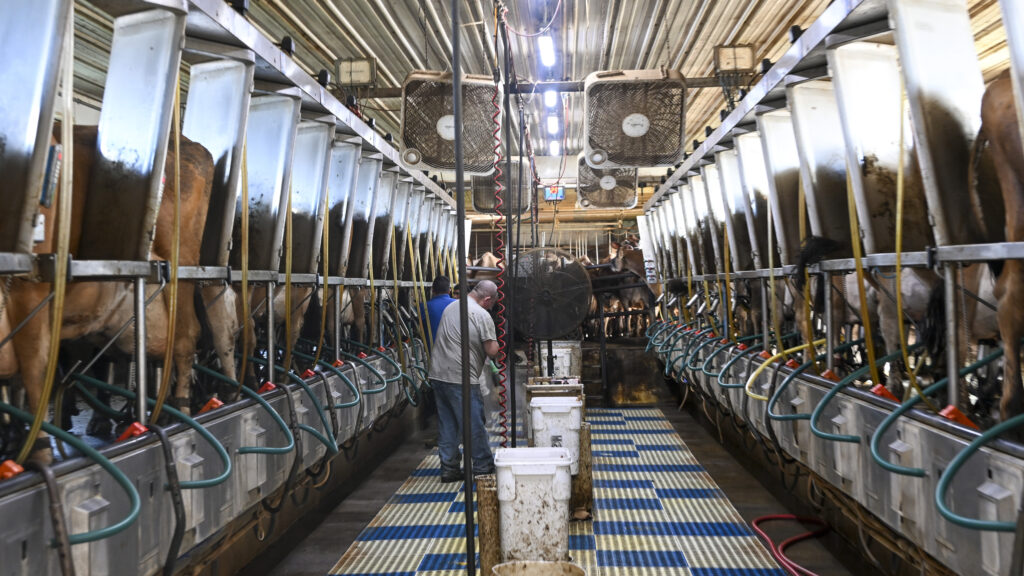For months, as human cases of H5N1 bird flu associated with an outbreak of the virus in U.S. dairy cattle have mounted, one question has loomed larger than others: how many human infections are getting missed?
Farmworkers face some of the most intense exposure to the bird flu virus, but resistance from farmers and a lack of health insurance and paid sick leave in the industry have limited the amount of testing of workers and hampered public health officials’ ability to track where the virus might be spreading. Now, long-awaited results from blood testing conducted by the Centers for Disease Control and Prevention are starting to fill in the picture.
advertisement
The findings, published Thursday, suggest that a small but not insignificant number of H5N1 infections are going undetected among people who work with dairy cows. Blood samples taken from 115 farm workers in Michigan and Colorado over the summer found evidence of a recent infection in eight individuals — half of whom recalled being ill around the same time the cows were sick. The other half could not recall having any symptoms.
Known as serological surveys, the studies involve fishing out antibodies in the blood — molecules made by the immune system in response to a pathogen’s attack that persist long after an infection is over. Finding them is a signal of past contact with a particular virus and helps scientists understand how widely it has spread.
While the new results suggest that current public health efforts are missing cases, they do not indicate that the strain of H5N1 associated with the dairy cattle outbreak has gained the ability to spread from person to person.
advertisement
“There is nothing we’ve seen in the new serology data that gives rise to a concern about person-to-person transmission,” Nirav Shah, the agency’s principal deputy director, said at a press conference Thursday morning.
The agency believes the virus continues to pose a low risk to the general public.
So far this year, 45 people have been infected with H5N1 tied to exposures to cattle or poultry, with one additional case with an unknown source. CDC officials said that the newly uncovered infections would not be added to the list of confirmed cases. But the study gives fresh urgency to reports of undiagnosed ailments among farmworkers and veterinarians.
In response to the new data, the CDC is now recommending that any farm workers who were exposed to infected animals be tested for H5N1, whether or not they have symptoms. Previously, the agency advised that only individuals who had been exposed and had symptoms be tested.
The purpose of this expansion is to intensify case-finding efforts, so that even workers with mild or unnoticeable infections can be offered treatment and isolation. The CDC is also recommending that Tamiflu be offered to any individuals on a farm with infected animals who’ve had a high-risk exposure — like being splashed with milk from a dairy cow or participating in a culling operation on a poultry farm — without adequate personal protective equipment.
The CDC’s study found that all eight people with H5N1 antibodies had reported cleaning milking parlors, and most reported milking cows. None of them reported wearing respiratory protection and fewer than half wore eye protection. Other research has shown that H5N1 seems to be primarily infecting mammary glands — the amount of virus in the udders of infected cows is very high, and it can stay alive on surfaces and milking machines for hours, leaving little doubt that a lot of spread is happening in milking parlors.
While human cases so far have been mild, public health officials worry that with infections, the virus has a greater opportunity to pick up mutations that could make it more dangerous.
advertisement
“Simply put, the less room we give this virus to run, the fewer chances it has to cause harm or damage,” Shah said. “The best way to do that is to identify, treat, and isolate as many cases as possible in humans as quickly as possible.”
However, it remains unclear what sort of impact these new recommendations will have in curbing the H5N1 outbreak, given realities on the front lines and the CDC’s lack of legal authority to order cooperation. Many farmers have been reluctant to allow public health officials on-site to conduct testing and have pushed back against offers of free personal protective equipment for workers. In many cases, environmental conditions make PPE almost unusable in dairies — extreme heat waves in California this summer not only resulted in more severe disease among animals, but made wearing masks and goggles too hot, or even dangerous, for workers.
While Tamiflu is effective at decreasing the amount of virus in a person’s body, and therefore lowering the risk of any onward transmission and the chances the virus has to mutate, it works best when given as early as possible within 48 hours of the onset of symptoms. Getting a prescription filled in that timeframe could prove challenging for farm workers, who often live in remote places and may not have transportation to reach medical care.
Public health authorities in states like Michigan and Colorado have been especially successful at making inroads with farmers, allowing them to carry out these kinds of studies in collaboration with the CDC. Other states, like California, where nearly half of the confirmed human cases have been reported in the last few weeks, have not yet indicated whether they will be conducting serological work of their own.
The CDC said it is continuing to try to learn more about the extent to which H5N1 has caused unnoticed infections among people working closely with cows, in any way it can. In September, at the annual conference of the American Association of Bovine Practitioners in Columbus, Ohio, about 150 veterinarians provided blood samples to be tested for evidence of H5N1 antibodies.
advertisement

